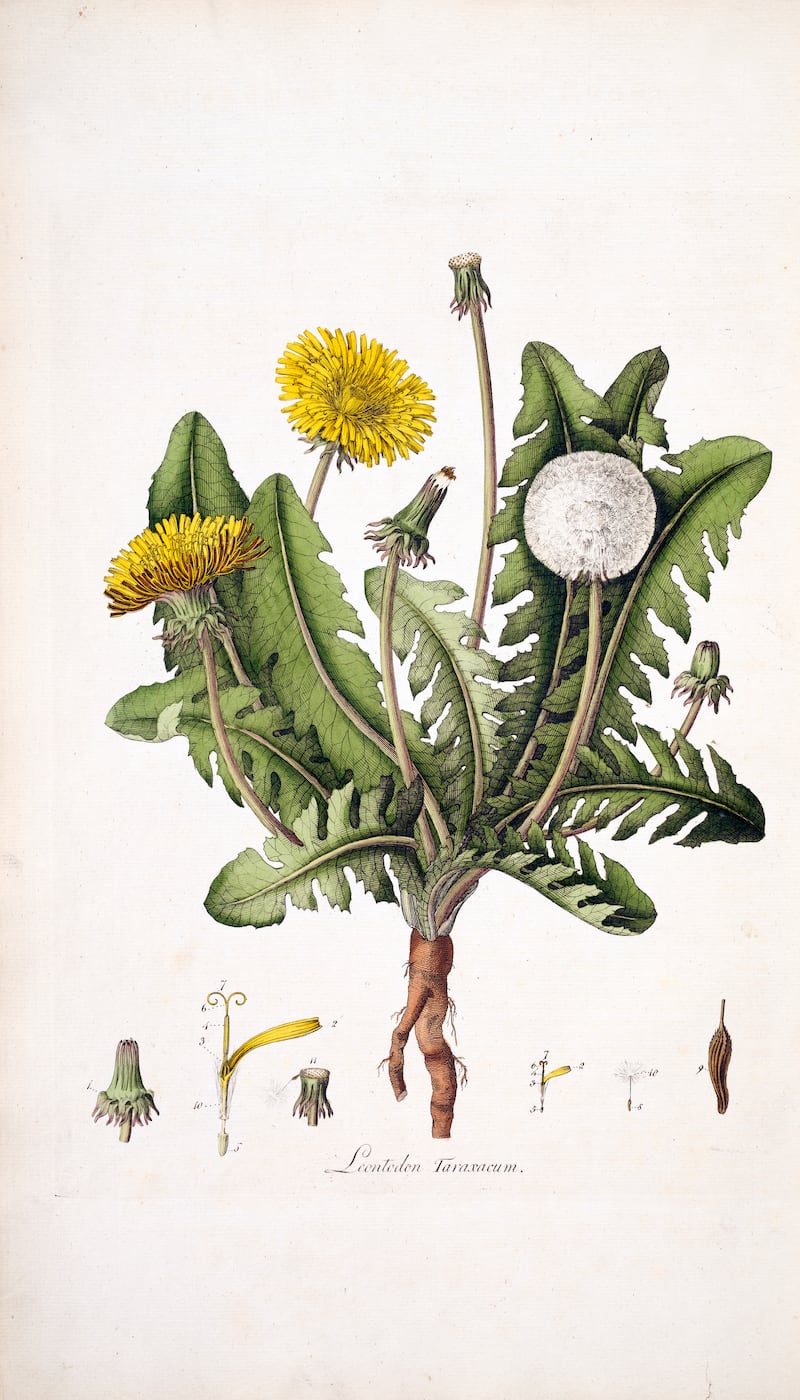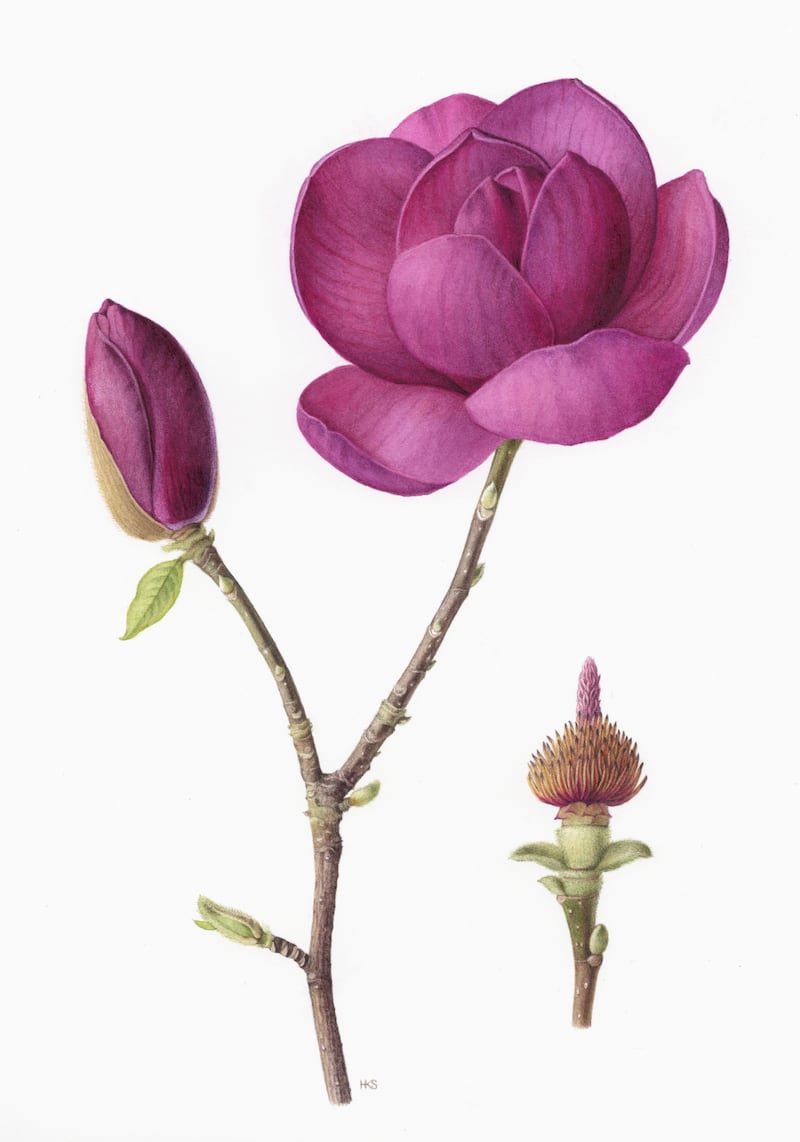They say a picture tells a thousand words. But in the case of botanical art it’s fair to say that it’s probably far more than that, as proven by a magnificent new book Drawn from Nature: The Flowering of Irish Botanical Art by the Wicklow-based art historian and author Patricia Butler (Acc Art Books UK, £35).
Charting the history and evolution of Irish botanical art from the early work of 17th-century artists such as James Gwim (who also contributed illustrations to Milton’s Paradise Lost), to a host of contemporary Irish artists, this is a meticulously-researched and beautifully-illustrated publication which is impressively comprehensive in its scope.
It’s also a fascinating record of interesting lives led by interesting people, whose talents as recorders of beauty leave behind a legacy that stretches out far beyond the world of botany and horticulture into the realms of craft and design as well as ecology and natural history.
Take, for example, the copperplate engravings of the remarkable 18th-century Irish botanical illustrator William Kilburn’s exquisite watercolour drawings of common native wildflowers, which feature in the first volume of William Curtis’s Flora Londinensis, a field guide to the wild flowers of London published in 1777. Botanically exact in every detail, Kilburn’s drawing of a dandelion plant elegantly illustrates each developmental stage of the life cycle of this resilient native perennial weed. We see its bright golden flowers both tightly in bud and fully open, as well as its sculptural, globe-shaped seed-heads, the silver “clocks” or “Jenny Joes” that we all blew on as children.
Actor Armie Hammer resurfaces as host of celebrity podcast
Heart-stopping Halloween terror: 13 of cinema’s greatest jump scares
Doctor Odyssey’s core message: just imagine Pacey from Dawson’s Creek holding you tight and saying, ‘Shhh, it’s okay’
Conor Niland’s The Racket nominated for William Hill Sports Book of the Year
In just one single drawing Kilburn succeeds in conjuring up the plant’s hollow, sap-filled flower stems, its coarse, fleshy tap-root (show me the gardener who hasn’t at some stage struggled to wrest this plant’s stubborn roots from the ground) as well as its distinctive basal rosette of deeply-lobed leaves.
Arranged beneath the main drawing as a series of dainty close-ups in miniature are further tiny drawings by Kilburn of dissections of the various plant parts. Here, in a way that no photograph could, Kilburn perfectly illustrates the graceful, barely-there curls of the “bilobed stigma” or female part of the dandelion’s flower which it uses to catch pollen, along with one of its many golden “ligules” or petals.
We see the flower’s slender style, its anther, and its ovary where the plant’s seeds are produced. There’s even an illustration of the flower stem’s pale, naked receptacle (what remains of its seed-head after the wind sends each tiny seed parachuting off in search of a suitable place to germinate). Drawn almost 250 years ago, every single part of Kilburn’s dandelion plant is instantly identifiable to a modern botanist, serving both as art and as an important record of natural history.
Born in Dublin in 1745, this Irish-born artist’s extraordinary talents as a botanical illustrator led him to a far more profitable and much-celebrated career as a textile designer in the UK, before his death at the age of 73 in 1818. A good friend and neighbour of the philosopher and politician Edmund Burke, his timeless, exquisite and much-copied, botanically-inspired designs form part of the Victoria & Albert Museum’s collection of textiles, where they continue to influence and inspire a new generation of artists and designers.
Patricia Butler’s new book also serves as a fascinating record of changing social norms and the limited professional opportunities available to earlier generations of female botanic artists. So, unlike William Kilburn, who quickly became a well-known name in the field of art and design, or the Victorian botanical illustrator and field geologist George Victor du Noyer, who recorded the different flora and fauna brought back by field officers working for the first Ordnance Survey of Ireland during the 1830s, the work of many Irish women artists of the 18th, 19th century and early 20th century remained relatively little-known until quite recently. This is despite the fact that botanical illustration was increasingly encouraged as an acceptable and fashionable hobby for young, educated, upper-class women who had the time, energy, opportunity and resources to pursue it.
The Irish botanist Ellen Hutchens, for example, lived a very isolated existence in Bantry, west Cork, where she died in 1815 aged only 30, yet left behind her a remarkable legacy in terms of both botanical knowledge and illustration. Best known for her exquisitely detailed drawings of many different seaweeds, she was friends with Charles Darwin, who thought her one of the greatest naturalists he had ever known.
Others, such as the Kildare-born artist Lydia Shackleton (1828-1914), found an outlet for their talents through the patronage of the National Botanic Gardens in Glasnevin, whose then-director Sir Frederick Moore commissioned Shackleton to record the garden’s collection of orchids.
A few, such as the intrepid Irish botanical watercolourist and plant collector Lady Charlotte Wheeler-Cuffe (1867-1967), who travelled with her civil engineer husband Sir Otway Wheeler-Cuffe through the remotest regions of Burma, put their talents to work recording the botanical beauty of far-flung places. Wheeler-Cuffe’s distinctive watercolours of Burmese orchids now form part of the National Botanic Gardens’ own collection of botanical art.

Other distinguished female artists covered in Butler’s book include the incomparable Mary Delany (1700-1788), whom the author describes as one of the most gifted women of her age, especially in the applied arts. As a young widow Delany enjoyed an unusual level of social freedom and became good friends with the British explorer, botanist and scientist Sir Joseph Banks as well as the Irish poet and author Jonathan Swift. Born in England, her career as an artist began to blossom during the years she spent living in Ireland with her second husband Dr Patrick Delaney (Dean of County Down, and tutor at Trinity College), where she developed a keen love of gardening and became a master of the art of découpage, using hundreds of tiny pieces of paper to assemble exquisite, botanically-correct illustrations of different flowers. By the end of her life her florilegium, or what she described as her “hortus siccus”, contained almost 1,000 of her astonishingly intricate flower studies and now forms part of the collection of the British Museum.
Fast forward to the early decades of the 21st century, and women hugely outnumber men in terms of Ireland’s botanical artists. Many are members of the thriving Irish Society of Botanic Artists, the countrywide organisation set up in 2014. Six years after its establishment, just as the global pandemic began to unfold, the society mounted a group exhibition Drawn from Nature: the Flowering of Botanical Art in the National Gallery of Ireland, showcasing the work of many of its leading artists, which Patricia Butler curated, and which inspired her to write this new book of the same name.
Lush examples of their masterful work features amongst its pages; they include Mary Dillon’s study of the delicately ruffled petals of Tulipa ‘Black Parrot’, a vivid reminder of how nature has always been such a fertile source of inspiration for fashion and textile designers; Siobhán Larkin’s sculptural study in watercolour and pencil of the branch of an apple tree in fruit, its slender twigs softly clothed in silver lichen; Yanny Petters’ distinctive painting of a bee orchid using the ancient technique known as “Verre Églomisé”; Holly Somerville’s striking watercolour of the dark burgundy, tulip-like flowers of Magnolia ‘Black Tulip’ unfurling on a bare branch; and Jane Stark’s elegant portrait of the sun pitcher plant in full flower.

The distinctive work of other Irish botanic artists including the late, great Wendy Walsh, Susan Sex (an artist who studied under Walsh and who has subsequently done much to foster the talents of a new generation of Irish botanical illustrators), Deborah Lambkin and Lynn Stringer also feature amongst its pages. Each is a unique celebration of the great beauty, diversity and complexity of the natural world, showing us a way of seeing that goes far beyond the power of any camera.
This week in the garden
Collect the fallen leaves of deciduous species of trees and shrubs and store them in a bag or in a pile (see last week’s column) to make leaf mould. Free, easy to make and brilliant as a humus-rich soil conditioner, mulch or addition to a home-made seed or potting compost, leaf mould encourages healthy, vigorous plant growth and nourishes soil health.
As long as soil conditions aren’t waterlogged this is a good time of year to plant a wide range of trees, shrubs, hedging and fruit varieties. Where possible choose the bare-root option which is much cheaper and more environmentally friendly (there’s no peat-based compost to worry about while transport is easier and less costly).
Dates for your diary
Sunday, November 26th, Sunday, December 3rd and Sunday, December 10th (10am-1pm), The Grinding House, June Blake Garden, Tinode, Blessington, Co Wicklow, seasonal Christmas wreathmaking workshops with garden writer and flower-farmer-florist Fionnuala Fallon, see eventbrite.com/o/fionnuala-fallon-74563213293 or @theirishflowerfarmer to book tickets
November 28th (8pm-9.30pm), Foxrock Church Pastoral Centre, Dublin 18, Travels on Easter Island a talk by nursery owner and RHS Chelsea gold medal winner Billy Alexander on behalf of the Foxrock & District Garden Club, see foxrockgardenclub.com






